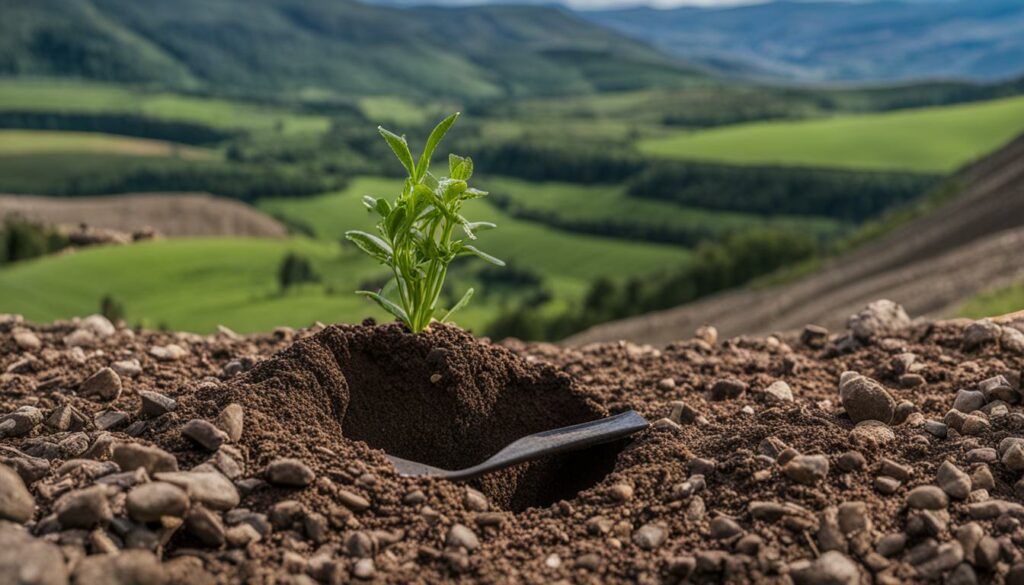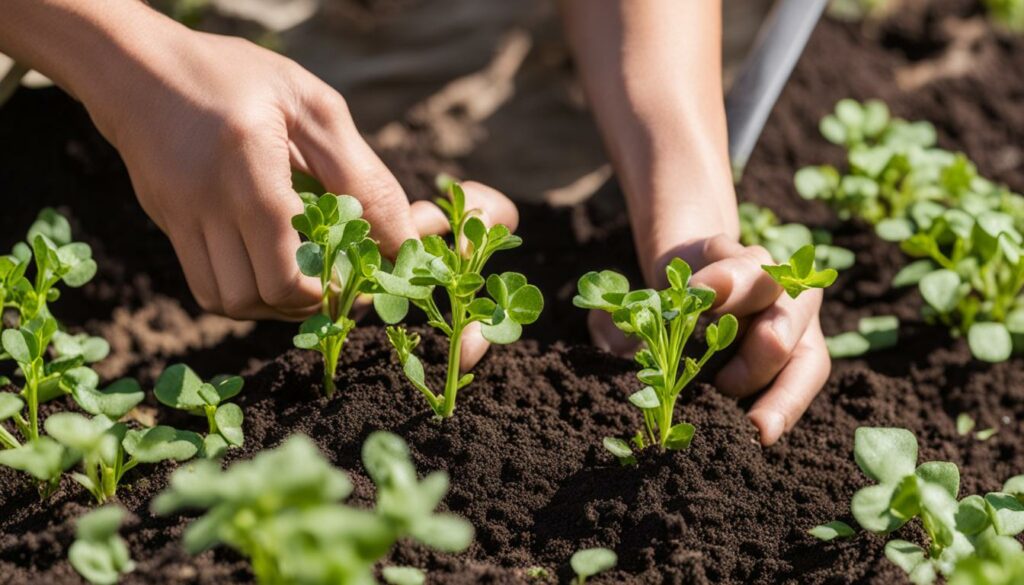Welcome to our comprehensive guide on how to plant rock cress seeds! If you’re looking to add a splash of vibrant color to your garden, rock cress is the perfect choice. In this step-by-step rock cress seed planting guide, we’ll provide you with all the tips, instructions, and best practices you need to successfully grow rock cress from seeds.
Rock cress, also known as Arabis, is a beautiful low-growing perennial plant that blooms with masses of pretty flowers in the spring. Its hardy nature allows it to thrive in challenging areas such as hills and slopes, making it a versatile addition to any garden.
Whether you’re a seasoned gardener or a beginner, our rock cress seed planting techniques and advice will help you achieve stunning results. So, let’s dive right in and learn how to plant rock cress seeds!
When and Where to Plant Rock Cress Seeds
Knowing the right time and place to plant rock cress seeds is crucial for their successful growth and development. Rock cress seeds can be directly sown into the garden in early spring or started indoors before the last expected frost. This allows the seeds to take advantage of the cool temperatures and moist conditions that are favorable for their germination.
When selecting a location for planting rock cress seeds, it is important to choose an area that receives full sun to partial shade. Rock cress thrives in these light conditions and will produce abundant blooms when provided with at least six hours of sunlight per day. Additionally, rock cress requires well-draining soil with a slightly acidic pH. This ensures that excess moisture does not accumulate around the roots, which can lead to rot and other plant health issues.
Rock cress can be planted in a variety of settings, including rock gardens, retaining walls, and sandy ledges. Its low-growing habit makes it perfect for creating borders or trailing over walls and slopes. To improve drainage and provide essential nutrients for growth, it is recommended to add compost or peat moss to the soil before planting. This will help create an optimal growing environment for rock cress seeds, allowing them to thrive and produce beautiful flowers.
| When to plant rock cress seeds | Where to plant rock cress seeds |
|---|---|
| Early spring or before the last expected frost | Rock gardens, retaining walls, sandy ledges |
| Full sun to partial shade | Well-draining soil with slightly acidic pH |
| – | Add compost or peat moss to improve drainage |
How to Plant Rock Cress Seeds
To plant Rock Cress seeds, follow these simple steps:
- Prepare the soil: Choose a sunny location with well-draining soil. If the soil is heavy or clay-like, add organic matter such as compost or peat moss to improve drainage.
- Scatter the seeds: Sprinkle the seeds evenly over the prepared soil. To ensure even distribution, you can mix the seeds with sand or vermiculite.
- Press the seeds gently: Lightly press the seeds down into the soil with your fingers or a small tool. This will help them make good contact with the soil.
- Water the soil: Use a fine mist or a watering can with a rose attachment to gently water the soil. Avoid using a strong stream of water that could disturb the seeds.
- Maintain moisture: Keep the soil moist but not waterlogged until the seeds germinate. This usually takes around 7 to 14 days. Water regularly, especially during dry spells.
- Thin out seedlings: Once the seedlings have emerged, thin them out to give each plant enough space to grow. This will help prevent overcrowding and promote healthy growth.
Remember to label the planting area so you can identify the Rock Cress as it grows. With proper care, your Rock Cress seeds will sprout and develop into beautiful, blooming plants.
“Sowing Rock Cress seeds is a rewarding experience. Watching the tiny seeds grow into vibrant plants that adorn your garden is truly magical.”
Care Tips for Rock Cress
Proper care is essential for the healthy growth and longevity of rock cress plants. Here are some tips to help you care for your rock cress:
Watering:
Rock cress requires regular watering, especially during the growing season. It is important to keep the soil moist but not waterlogged. Overwatering can lead to root rot or crown rot, which can be detrimental to the plant’s health. Water the plants deeply and thoroughly, allowing the water to penetrate the root system.
Fertilizing:
Using a balanced, all-purpose fertilizer in the spring and summer can provide the necessary nutrients for rock cress growth. Follow the instructions on the fertilizer packaging for the correct application rate. Be careful not to overfertilize, as this can lead to excessive foliage growth and fewer blooms.
Deadheading:
Deadheading, or removing spent flowers, can help prolong the blooming period of rock cress. This process encourages the plant to produce more blooms, resulting in a more vibrant display. Simply pinch or snip off the faded flowers at the base to keep the plant looking tidy and promote continuous flowering.
Preventing Pests and Diseases:
Rock cress is generally resistant to common pests and diseases. However, it can occasionally attract aphids and whiteflies. To manage these pests, you can use insecticidal soap or neem oil. Ensure that the plants have enough space for proper air circulation to prevent fungal diseases such as root rot or crown rot. Additionally, providing well-draining soil and avoiding overwatering can help prevent these issues.
By following these care tips, your rock cress plants will thrive and continue to beautify your garden with their colorful blooms.

Rock Cress Varieties and Planting Options
Rock Cress, scientifically known as Aubrieta deltoidea, offers a variety of cultivars with stunning flower colors. From vibrant pinks and purples to delicate whites and variegated options, there is a Rock Cress variety to suit every garden. These colorful blooms can add a touch of beauty and charm to rock gardens, borders, slopes, and even as ground cover.
Rock Cress is a popular choice among gardeners due to its compact, low-growing habit and its ability to thrive in well-drained soil. It can withstand challenging conditions, making it an excellent choice for areas where other plants struggle to survive. Whether you’re looking to create a colorful border or add a pop of color to a rocky landscape, Rock Cress can be a versatile and visually appealing option.

Planting Options
When it comes to planting Rock Cress, there are various options to consider. One popular choice is to incorporate it into rock gardens, where its low-growing habit and vibrant flowers can complement the surrounding stones. The trailing nature of Rock Cress also makes it an ideal candidate for planting at the edges of retaining walls, where it can cascade gracefully over the edges.
Additionally, Rock Cress can be planted on sandy ledges and slopes, where its ability to thrive in well-drained soil comes in handy. Its compact growth makes it a great ground cover option, providing color and texture to areas that may otherwise be barren. For an extra burst of color, you can even plant Rock Cress under spring-flowering bulbs, creating a visually stunning display.
In summary, Rock Cress varieties offer a wide range of options for adding color and beauty to your garden. Whether you choose to plant them in rock gardens, borders, slopes, or as ground cover, Rock Cress is a versatile plant that can thrive in various conditions. Its vibrant flowers and ability to attract pollinators make it a delightful addition to any garden.
Propagation and Harvesting of Rock Cress
Rock Cress, also known as Arabis, can be propagated through different methods such as division, cuttings, or seeds. Each method has its own advantages and can be chosen based on personal preference and availability of resources.
Propagation Methods
1. Division: This method involves dividing mature Rock Cress plants into smaller sections and replanting them. It is best done in early spring or fall when the plants are not actively growing. To divide the plants, carefully dig them out of the ground and separate the sections. Make sure each section has roots attached to it. Replant the divided sections in well-prepared soil and water them thoroughly.
2. Cuttings: Taking stem cuttings is another effective way to propagate Rock Cress. In early summer, select healthy stems from the parent plant and cut them just below a leaf node. Remove the lower leaves and dip the cut ends in a rooting hormone. Plant the cuttings in a well-draining potting mix and keep them in a warm and bright location. Water the cuttings regularly and within a few weeks, they will develop roots and can be transplanted into the garden.
3. Seeds: Propagating Rock Cress from seeds is relatively easy. Collect the seeds from mature plants in late spring or early summer. Scatter the seeds on top of well-prepared soil and lightly press them down. Water the soil gently and keep it consistently moist until the seeds germinate. Thin out the seedlings once they have emerged to provide adequate space for growth.
Harvesting Rock Cress
Rock Cress flowers can be harvested when they are fully open in early summer. Cut the flowers close to the base of the plant using clean, sharp scissors or pruning shears. The harvested flowers can be used as a decorative garnish for dishes or incorporated into floral arrangements for a pop of color. Harvesting the flowers regularly can encourage the plant to produce more blooms throughout the season.

Rock Cress seeds can be propagated through division, cuttings, or seeds, allowing gardeners to expand their collection and share the beauty of this versatile plant. Harvesting the vibrant flowers adds a touch of color and elegance to culinary creations and floral arrangements. So whether you prefer the simplicity of sowing seeds or the satisfaction of propagating from cuttings, Rock Cress provides an abundance of opportunities to grow and enjoy its beauty in your garden.
Pest and Disease Management for Rock Cress
Rock Cress is known for its resilience and resistance to pests and diseases, making it a relatively low-maintenance plant. However, like any other plant, it can occasionally encounter issues that require attention. By implementing proper pest and disease management strategies, you can ensure the health and vitality of your Rock Cress plants.
Common Pests
While Rock Cress is generally resistant to pests, it can attract aphids and whiteflies. These small insects feed on the plants’ sap, causing damage to the foliage and potentially spreading diseases. If you notice an infestation, promptly address it to prevent further damage. A simple and effective solution is to use insecticidal soap or neem oil, which are safe and eco-friendly options for controlling pests.
Disease Prevention
Rock Cress is susceptible to fungal diseases, such as root rot and crown rot, especially when grown in poorly draining soil. To prevent these diseases, it is crucial to provide proper drainage for the plants. Avoid overwatering and ensure that the soil has good airflow. Additionally, spacing the plants adequately can help prevent the spread of diseases by allowing for better air circulation.
| Pest or Disease | Symptoms | Prevention | Treatment |
|---|---|---|---|
| Aphids | Stunted growth, curled leaves, sticky residue on leaves | Regularly inspect plants, apply insecticidal soap or neem oil | Use insecticidal soap or neem oil as directed |
| Whiteflies | White, winged insects on the undersides of leaves | Monitor plants closely, use insecticidal soap or neem oil | Apply insecticidal soap or neem oil as recommended |
| Root Rot | Wilting, yellowing leaves, rotting roots | Ensure well-draining soil, avoid overwatering | Remove affected plants, improve drainage, refrain from overwatering |
| Crown Rot | Discolored, mushy crown, wilting foliage | Provide proper soil drainage, avoid overwatering | Remove affected plants, enhance soil drainage |
By being proactive in pest and disease management, you can maintain the health and beauty of your Rock Cress plants. Regularly inspecting your plants, practicing good cultural practices, and using appropriate treatments when necessary will help ensure the longevity and vitality of your Rock Cress.

Conclusion
Rock Cress is a stunning and versatile plant that can bring vibrant colors to any garden. By following these rock cress gardening tips, you can easily grow this beautiful perennial from seeds. Whether you choose to plant it in rock gardens, borders, slopes, or as ground cover, rock cress is a low-maintenance option that thrives in various conditions.
With its ability to attract pollinators and its resistance to pests and diseases, growing rock cress from seeds is a rewarding experience for garden enthusiasts. Its compact, low-growing habit and the variety of flower colors make it a perfect choice for adding an extra pop to your outdoor space.
So why wait? Start your rock cress gardening journey today and enjoy the splendor of its pretty flowers year after year. Whether you’re a beginner or an experienced gardener, rock cress is a delightful addition that will surely enhance the beauty of your garden.
FAQ
How should I plant rock cress seeds?
Scatter the seeds on top of the soil and lightly press them down. Mix the seeds with sand or vermiculite for even distribution. Gently water the soil with a fine mist and keep it moist until the seeds germinate.
When is the best time to plant rock cress seeds?
Rock cress seeds can be directly sown into the garden in early spring or started indoors before the last expected frost.
Where should I plant rock cress seeds?
Rock cress thrives in full sun to partial shade and prefers well-draining soil. It can be planted in rock gardens, at the edges of retaining walls, or on sandy ledges and hills.
How do I care for rock cress?
Rock cress requires regular watering during the growing season. Use a balanced, all-purpose fertilizer in the spring and summer. Deadhead spent flowers to encourage more blooms. Provide proper drainage and avoid overwatering to prevent root rot or crown rot.
What are the different varieties of rock cress and where can I plant them?
Rock cress, scientifically known as Aubrieta deltoidea, comes in pink, purple, white, and variegated options. It can be used in rock gardens, borders, slopes, and as ground cover. It can also be planted under spring-flowering bulbs for additional color.
How can I propagate rock cress?
Rock cress can be propagated through division, cuttings, or seeds. Dividing mature plants in early spring or fall and replanting the sections can create new plants. Taking stem cuttings in early summer and rooting them in well-draining potting mix is another method. Harvest the flowers when fully open in early summer for decorative purposes.
How do I manage pests and diseases for rock cress?
Rock cress is generally resistant to pests and diseases. However, it can occasionally attract aphids and whiteflies, which can be managed with insecticidal soap or neem oil. Proper drainage and avoiding overwatering can help prevent fungal diseases like root rot or crown rot.
Do you have any additional tips for growing rock cress?
Rock cress is a beautiful and versatile plant that can thrive in various conditions. With its ability to attract pollinators and resistance to pests and diseases, it is a great addition to any garden. Follow the planting and care instructions provided for the best results.





